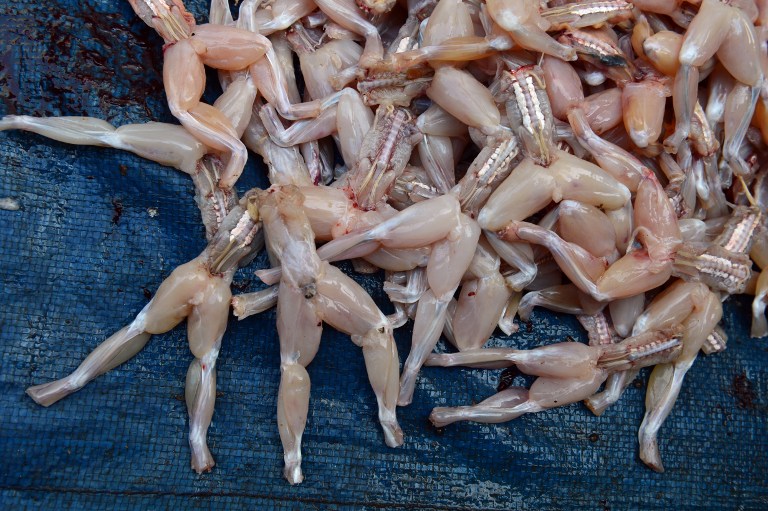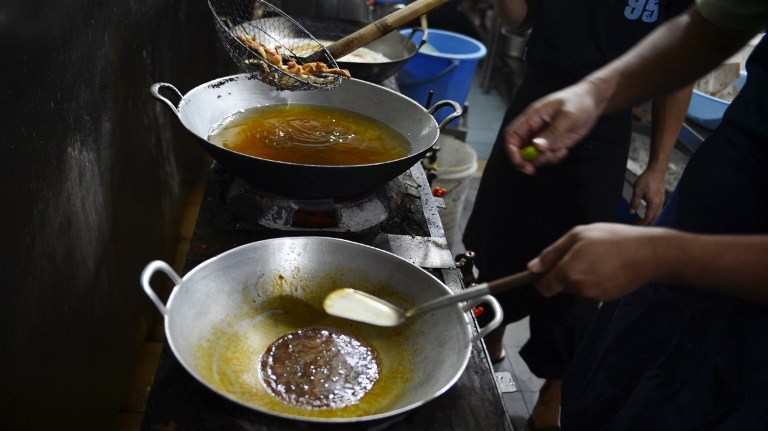
The Indonesian frog vendor closes her eyes, asks Allah for his blessing, and with one swift strike of a cleaver beheads the trembling creature.
Though diners in white table-clothed French brasseries may not know it, their frogs legs most likely come from the murky swamps of tropical Indonesia, caught by hunters in the dead of the night to be slaughtered and sold at local markets.
As mechanically as a factory worker, Sri Mulyani rips off the frog's skin, pulls out its innards with her bare hands and flings the amphibian onto a mountain of others that have suffered the same fate.
"If I feel disgusted and sick of frogs, I just think about the money," the smiling 41-year-old told AFP at an early-morning market in Bogor, on the outskirts of the capital Jakarta.
Mulyani and her frog-hunter husband, Suwanto, 48, make up to 500,000 rupiah ($52) a day -- well above the local minimum wage of around $200 a month -- chasing and selling frogs to restaurants or middlemen for export.





The Indonesian frog vendor closes her eyes, asks Allah for his blessing, and with one swift strike of a cleaver beheads the trembling creature.
Though diners in white table-clothed French brasseries may not know it, their frogs legs most likely come from the murky swamps of tropical Indonesia, caught by hunters in the dead of the night to be slaughtered and sold at local markets.
As mechanically as a factory worker, Sri Mulyani rips off the frog's skin, pulls out its innards with her bare hands and flings the amphibian onto a mountain of others that have suffered the same fate.
"If I feel disgusted and sick of frogs, I just think about the money," the smiling 41-year-old told AFP at an early-morning market in Bogor, on the outskirts of the capital Jakarta.
Mulyani and her frog-hunter husband, Suwanto, 48, make up to 500,000 rupiah ($52) a day -- well above the local minimum wage of around $200 a month -- chasing and selling frogs to restaurants or middlemen for export.

Skinned frog legs. ©AFP
Devoured for their fleshy chicken-like taste, frogs legs are a known delicacy in France, Belgium and Luxembourg, but are also prized in Indonesia and China.
Indonesia has become the world's biggest exporter of frogs, providing more than 80 percent of Europe's imports, almost all caught in the wild by village-style frog hunters like Suwanto.
But conservationists are concerned the lucrative trade may see the end to certain frog populations that help keep ecosystems healthy by preying on pests. Their tadpoles also help stabilise aquatic environments.
Much of the demand comes from France, where an estimated 80 million frogs are consumed every year. France was forced to place a ban on commercial frog hunting and farming in 1980.
The trade moved mostly to India and Bangladesh, but those countries too banned exports in the late 1980s as their frog populations drastically depleted.

Skinned frog legs are cooked at an Indonesian restaurant in Bogor. ©AFP
"We fear that over the years the frog population, at least the large body of frogs in Indonesia, will collapse," said Sandra Altherr from German group Pro Wildlife, which co-authored a report on the frog trade last year.
"History has given us a lesson and we should learn from it."
-- 'Free-range frogs' --
But for Suwanto the work is too lucrative to give up, and frog hunting, he said, is in his blood.
"I've been hunting frogs since 1992, and my father before me was a frog hunter," Suwanto said, adding he was unsure if the tradition would continue in his family as he only had daughters, explaining frog hunting was men's business.
From behind his home, Suwanto and a group of fellow frog hunters set off into the darkness each night at 8:00 pm, tip-toeing through the the rice paddies and streams.
The men often hunt into the early hours of the morning, with no talking in case the noise scares the slippery creatures away.
Their modus operandi looks simple -- barefoot and armed with small handlamps, they use nets attached to long wooden poles to scoop up the frogs they find in the muck of the fields and riverbanks.
But beyond their basic tools, the frog hunters seem to have a sixth sense for the amphibians, gathering dozens in just minutes from what would otherwise be an indistinguishable patch of dark swamp.

Cooked frog legs. ©AFP
The men catch 50 to 70 kilograms (110 to 150 pounds) of Asian brackish (a crab-eating frog) and giant Javan frogs each night, much of which will feed the domestic market, estimated to be two to seven times the export volume.
While the thought of eating frogs from the unregulated Indonesian wild may make some shudder, Chinese-Indonesian Ferdian Zhang, 37, wouldn't have it any other way, buying all his frogs legs from Mulyani for his Bogor restaurant.
"They're free-range frogs, caught in the wild like free-range chickens. You just can't compare the taste," he said.
The local market is dominated by the Chinese-Indonesian minority, as many in the Muslim majority believe eating frogs legs is "haram" (forbidden).
Altherr's conservation group hopes to draw attention to the issue at this month's Convention on International Trade in Endangered Species (CITES) conference in Bangkok, aiming to get several frog species on a protected list.
But Sri Mulyani has faith the frog population will continue to flourish.
"God will protect us and be fair to us, and make sure there are always frogs," she said.
That is, of course, if she stops kissing the creatures, as she did on a recent delivery to Zhang's restaurant.
"Sri Mulyani kissed a frog and it turned into her husband!" Zhang said, laughing. "Suwanto is the frog prince."
by Kevin Ponniah from AFP

 +7 (777) 001 44 99
+7 (777) 001 44 99



 Қазақша
Қазақша Русский
Русский English
English














































